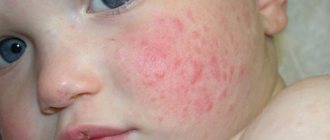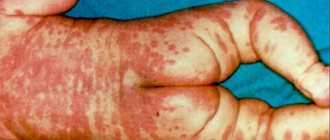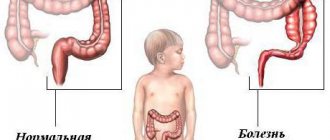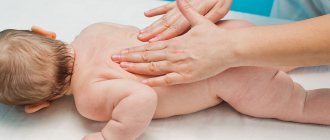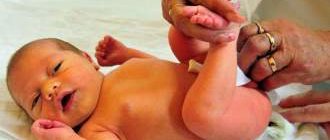Miliaria in adults can appear both as a result of poor personal hygiene and severe internal diseases. Sweat released onto the surface of the skin and not evaporating in a timely manner irritates the skin, as a result of which it becomes red, and the rash looks like an allergic reaction. The disease can appear in a variety of places: on the head, face, neck, arms and legs, on the back, under the arms, between the fingers and in the groin area in women and on the head of the penis in men. Miliaria often appears in overweight people; these rashes are localized in the folds of the skin. The rash resembles an allergic reaction and many people do not pay attention to it, which can lead to serious consequences.
Miliaria, a non-contagious rash, however, causes discomfort and unpleasant sensations, especially if the pathology manifests itself in a severe form.
If you observe skin rashes, you must urgently seek medical help, which will allow you to identify and eliminate the factors that provoke the disease and prevent the development of pathologies that require long and serious treatment.
Causes of prickly heat
The appearance of prickly heat is associated with inflammation of the skin as a result of hyperhidrosis. The mechanism of development of the pathological process is as follows: under the influence of elevated body temperature, the protective functions of its cooling are activated - the pores open, sweat comes out, which leads to cooling of the body. When pores are clogged with sebum, cosmetics, or when the air is humid and hot, the process of sweating slows down and sweat begins to evaporate slowly, causing skin irritation.
Sweat contains salts and biologically active substances, which cause irritation. If you slow down the removal of excess sweat, the process of microbial reproduction will begin on the skin. Inflammation of the sweat glands, which develops as a result of the proliferation of pathogenic agents, forms miliaria; a small rash appears on the skin, accompanied by certain subjective symptoms.
The causes of the disease are divided into natural and pathogenic.
Natural causes include external factors not related to a person’s general health. Miliaria may appear as a result of:
- Wearing tight clothing made of synthetic material. The rash is localized on areas of the skin covered by clothing,
- Wearing tight shoes. Heat rash appears on the legs,
- Sports training or intense physical labor,
- Prolonged exposure of a person to a humid environment (dry hot climate) at high temperatures,
- Using low-quality cosmetics or cosmetics in large quantities. Cosmetics selected inappropriately for your skin type in large quantities can cause inflammation of the facial skin,
- Failure to comply with personal hygiene rules, in particular, prolonged exposure to sweat-soaked clothing, infrequent changes of shoes and socks for hyperhidrosis of the legs,
- Prolonged exposure to sunlight.
Pathogenic factors that provoke the appearance of prickly heat affect the functioning of the sebaceous glands, which leads to the appearance of the disease.
Common pathogenic causes include:
- Hyperhidrosis. It is a functional systematic disorder of the sebaceous glands, which results in increased sweating,
- Excess weight,
- Cardiovascular diseases and/or nervous disorders,
- Disorders of the endocrine system of a functional nature,
- Metabolic disorders
- Fever as a result of a sharp increase in body temperature,
- Strokes, paralysis and other pathological conditions that lead to bedridden conditions. In addition to prickly heat, people who are unable to move may also develop bedsores.
Heat rash: what is it?
This disease is often called summer disease. The air heated by the hot sun affects our skin, forcing the body to respond: sweat begins to be produced more actively than usual, the pores on the skin open, allowing the cool liquid to cool the body. Unfortunately, the mechanism clearly thought out by nature fails. Sometimes sweating is so profuse that the body cannot cope with it : the sweat glands become clogged, and then foci of inflammation appear on the skin - what experts call prickly heat.
The problems would not be so serious if it were not for the composition of sweat: it contains various biologically active components, and most importantly, salts that act on the skin as a strong irritant. In addition, sweat is a favorable environment for various microbes, which, by multiplying, intensify the inflammatory process.
Active sweating is also accompanied by such a phenomenon as psychosomatics, in which various human psychological problems are transformed into physical ailments. In this case, the patient may need the help of a psychotherapist, but in general, if he discovers signs of prickly heat, he should contact a therapist or dermatologist in order not only to quickly cure the disease, but also to make a correct diagnosis (skin inflammations are characteristic of many, including infectious diseases ).
What does prickly heat look like in adults, photo
Miliaria in adults can be of several types. There are three different subtypes of miliaria: papular, red and crystalline.
Visualization of rashes allows you to more clearly determine the specific type of pathology.
- Crystalline prickly heat in the photo has the form of frozen pearlescent drops, which consist of small (1 - 2 mm) painless, closely spaced vesicles. In some places it is possible to record their merging into large foci.
- The red form of miliaria has the form of red vesicles measuring 1–3 mm, which contain a cloudy liquid inside. In the photo you can see the resulting inflammatory, hyperemic crown around the papules.
- Papular miliaria is a type of miliaria rubra and develops from microbial eczema. In the photo you can see papules that are located in the dermis.
- Apocrine miliaria appears as a rash of small pink vesicles that may rupture.
Types of prickly heat and places of its manifestation
Most often, young children face the problem of heat rash . The skin of children is very thin and delicate, so they are more susceptible to dermatitis.
Miliaria in children most often appears in the following places:
- In the armpits.
- On the neck.
- On the buttocks.
- On the bends of the arms and legs.
- In the chest area.
Rashes can appear on any part of the body due to poor quality clothing. Synthetic fibers do not allow air to pass through to the baby's body, which is why a rash appears on the legs, arms and other parts of the body.
To avoid this, kids need to buy clothes made from cotton fabrics.
Important ! Especially often, this disease in newborns is localized between the legs due to the large number of folds in the child and a sedentary lifestyle.
In adults, rashes most often appear in the summer, when the air temperature rises and air humidity decreases.
In adults, the disease appears in places with a large number of sebaceous glands:
- On the back.
- In the groin.
- On the face.
- On the chest.
- On the lower back.
There are several types of dermatitis. They differ in rashes and places of appearance.
Types of prickly heat:
- Papular . This type of dermatitis often occurs in infants. Miliaria looks like a small red rash. If you look closely, you can see small beige bubbles with liquid with a diameter of 1 millimeter on the affected area of the body. This type of dermatitis is not dangerous at the initial stage, but it causes discomfort, peeling and itching in humans.
- Red . This type of inflammatory skin lesion is very easy to confuse with an allergic reaction. Outwardly, it looks like tiny bubbles of liquid that merge into one red spot. From a distance, this dermatitis resembles a first-degree burn. The skin becomes covered with a light crust. In advanced stages of prickly heat, the blisters burst.
- Crystalline . Rashes of this nature resemble small red grains with liquid in appearance. Miliaria crystalline is localized evenly throughout the body. Bubbles do not tend to merge. This type of dermatitis is easily felt tactilely.
Miliaria in the groin in men and its symptoms
The appearance of prickly heat in the groin of men is not uncommon. Pathology can also occur in women. The cause of the development of prickly heat in the groin area may be hyperhidrosis, when increased sweating is recorded. The condition may indicate tuberculosis, VSD, heart muscle disease.
Miliaria in the groin area can be provoked by:
- Climate change. Often prickly heat in men in the groin appears when traveling to warm countries where the climate is characterized by high levels of humidity and high temperatures. Usually, symptoms of diaper rash do not require treatment and go away on their own after acclimatization,
- Excess weight. Fat deposits lead to the formation of folds and rubbing of the inner thighs against each other, which leads to the appearance of heat rash,
- Allergic reaction. Pathology may appear due to wearing tight clothing made of synthetic material. First, skin irritation appears, then prickly heat develops,
- Violation of personal hygiene rules. Failure to comply with sanitation standards leads to the accumulation of large amounts of dead tissue and secretions, which are the optimal microflora for the reproduction and activity of pathogenic microorganisms.
Miliaria in the groin of a man manifests itself as a small rash containing exudate. Gradually the condition worsens, the following is observed:
- Skin hyperemia, swelling,
- Skin soreness and increased sensitivity,
- Formation of wounds.
Why does prickly heat occur?
The formation of prickly heat can be caused by various provoking factors.
Such provocateurs are:
- change of climate zone, for example, a trip to the south;
- dysfunction of the endocrine system;
- increased nervousness;
- intense physical labor;
- cold or infectious disease;
- uncomfortable clothing, especially made from synthetic fabrics;
- excess weight, which makes it difficult to move or perform any work;
- the use of cosmetics that clog pores and prevent the flow of oxygen.
Natural causes of prickly heat are lack of personal hygiene, wearing poor-quality shoes, high humidity in living and working areas, and tanning.
Adults are affected by miliaria in the presence of chronic pathologies:
- diabetes;
- metabolic dysfunction;
- heart and vascular diseases.
We must take care of ourselves!
To prevent the occurrence of prickly heat, you should remove provoking factors, choose clothes made of cotton, give yourself rest when doing hard work, and be in the shade more on hot days.
Heat rash on the legs in adults
Heat rash on the legs appears as a rash or small blisters that form on the surfaces of the skin. Often prickly heat appears on the feet, toes, arms, stomach, and groin. In these areas, clothing fits most tightly to the body, creating a greenhouse effect.
The causes and symptoms of heat rash on the legs generally do not differ from the causes and symptoms of other manifestations of this disease. The peculiarity of prickly heat on the legs is their localization. Rashes appear on the toes, between them and on the feet. The rashes can be clear, red or flesh-colored.
Crystalline prickly heat on the legs appears as white or transparent blisters up to 1 mm in size. In the photo you can see small groups of rashes that are combined. They can burst and become inflamed, which can lead to suppuration.
Miliaria rubra on the legs is revealed by expressive rashes in the form of nodules and blisters up to 2 mm in size. They are red in color and filled with cloudy liquid. This type of heat rash on the legs is characterized by severe itching.
Imaging allows you to see an accurate picture of papular heat rash on the legs. The legs are common sites for this type of heat rash. The rashes are small flesh-colored papules (vesicles) with a diameter of 1-2 millimeters.
Doctor Komarovsky's opinion
Evgeniy Komarovsky warns that a rash is not a cause, but a consequence, so first of all it is necessary to establish what caused it. Factors in the appearance of skin rashes can be diathesis, mechanical damage, various infections, allergies and even a reaction to blood clotting. First, you should try to determine whether the rash is dangerous or not, and then look for its culprit. If there are no signs of infectious diseases, the baby is cheerful and active, and of all the symptoms there is only a rash - the cause may be allergies, prickly heat or insect bites. Mommy will have to remember the previous day and try to figure out what could have caused the baby to get sick - buying new clothes, eating an orange, or being bitten by small insects.
Doctor Komarovsky warns! If the rash on the child’s skin has elements of hemorrhage, and the baby is vomiting, call an ambulance immediately!
The beloved doctor states that with the onset of heat, the appearance of prickly heat is not at all uncommon. A cluster of small pimples surrounded by reddened skin most often appears on the neck, gradually spreading to the face, back and chest, and behind the ears. Dr. Komarovsky advises diluting a teaspoon of soda in a glass of water and wiping the affected areas with a cotton ball soaked in the solution, lightly patting it several times a day. You can also use simple starch, using it instead of powder, but the main thing is to keep the baby undressed as often as possible in the heat. Let your baby take a break from diapers and tight clothes, and let his skin enjoy the touch of cool air.
READ ALSO: How to deal with dry hands? How to treat peeling hand skin?
Miliaria erythematosus in adults, treatment
Miliaria erythematosus in adults is an inflammatory type of disease. The disease is revealed by blistering rashes about 2 mm in diameter, red in color, which are often accompanied by inflammation in the superficial layers of the skin and severe itching. There is cloudy content inside the bottle. Over time, the disease progresses, the blisters burst and wet crusts appear, which indicates the addition of a bacterial infection. Miliaria rubra affects the armpits, skin between the buttocks, abdomen, elbows and forearms.
Miliaria rubra often appears in the groin area in overweight women. The disease requires serious treatment and does not go away on its own.
In most cases, prickly heat turns into a chronic disease with signs of infection.
Complicated miliaria requires treatment with antibacterial therapy using drying and anti-inflammatory drugs and antihistamines. Oral antibiotics may be prescribed if the disease or complications persist for a long time.
- Necessary measures are to eliminate factors that provoke pathology, maintain personal hygiene, treat the skin with antiseptic agents, improve skin ventilation, and maintain optimal temperature conditions in the room where the patient lives.
- Treatment of prickly heat begins with the use of local antiseptics. Boric and salicylic acids (1% alcohol solutions), chlorophyllipt are effective.
- Anti-prickly heat creams are used as a drying agent. Prescribe zinc ointment, calamine cream or dehistine. The ointment should be applied to clean skin with washed hands to prevent infection from entering the body.
- Powders that absorb excess sweat are effective. Baby powders, baneocin, and talc are prescribed.
- The appearance of the rash leads to wetting and itching. Special ointments relieve itching and have an antiseptic effect. The prickly heat ointment should have a non-greasy base to allow the skin to breathe after application.
- Antiseptics help destroy pathogenic microorganisms and dry the skin. Popular antiseptics include salicylic acid (alcohol solution), boric acid and an aqueous solution of potassium permanganate. Antihistamines are used to relieve swelling, inflammation, and itching. Tavegil, suprastin, fenkarol, cetrin are used.
- Oral antibiotics are used to treat miliaria erythematosus if there is a secondary infection associated with skin inflammation. Ciprofloxacin, azithromycin, amoxicillin, doxycycline are prescribed.
- The course of treatment for prickly heat also includes herbal medicine. The basis of this method are herbs and medicinal plants that have an antiseptic, disinfectant and drying effect. For prickly heat, baths with the addition of a decoction of chamomile, string, celandine or St. John's wort are recommended. The decoction is prepared from 4 tbsp. l. raw materials, which is poured into 1 liter of boiling water. The composition is infused until it cools completely, filtered and added to bath water.
- To treat prickly heat, oak bark is often used, which contains tannins, thanks to which the bark has a disinfecting, restorative and drying effect.
- A course of physiotherapy is also carried out, which includes reflexology and acupuncture. These methods provide an impact on the accumulation points of nerve endings associated with the center for regulating sweating in the brain.
Causes
Skin problems in babies are caused by the following factors:
- excess moisture accumulating in folds;
- hyperthermic effect;
- insufficient hygiene;
- incorrectly selected clothes;
- staying in a diaper for a long time (the skin does not breathe);
- reactions to washing powders, soaps or creams;
- inappropriate foods consumed by a nursing mother;
- unbalanced artificial nutrition;
- restriction of freedom of movement due to too tight swaddling.
The skin of a newborn is characterized by increased sensitivity and susceptibility to negative influences. Proper care can prevent diaper rash from occurring.
Excreta
Urine and feces irritate the baby's delicate skin in the buttocks and perineum. It is necessary to wash the child as often as possible, this should be done several times a day and always after each bowel movement.
The appearance of diaper rash is often associated with a craze for diapers, because diapers can create the illusion of dryness.
Improper use of diapers
The use of disposable hygiene items has made caring for infants easier, but often the absorbent capacity of the former does not meet the stated requirements. As a result, the baby's skin suffers from irritation, excess moisture and overheating (a greenhouse effect is created).
To avoid negative effects, you will need to change the diaper in a timely manner (at least every 3 hours and after each bowel movement). It is necessary to select high-quality diapers that do not cause allergic reactions in the newborn. The small size of the care item can lead to abrasions on the skin.
Improper skin care
The baby's skin may suffer both from excessive dryness and from the oily film that remains after applying the cream.
For bathing, you should use only neutral baby soap without dyes or fragrances; you should wash problem areas with it no more than once a day.
Bathing violation
It is necessary to bathe the baby every day before bed, and wash it after bowel movements and every diaper change. If pustules appear on the skin, you need to use boiled water with the addition of a slightly pink solution of potassium permanganate. Before use, the disinfectant must be filtered through several layers of gauze to prevent the grains from burning the skin.
Friction on clothes
A newborn's diapers and undershirts should be made from natural fabrics. All seams must be located on the surface of the products. It is necessary to select clothes only from soft fabrics so that friction against the skin does not lead to disruption of the integrity of the epidermis.
It is important to choose the right size, as clothes that are too tight can cause diaper rash. Sleeveless T-shirts and blouses with large appliqués and stripes should be avoided.
Allergic reactions
Allergies to skin care products can lead to redness, skin rashes and irritation. Sometimes a negative reaction develops to the material from which the diaper is made.
Skin irritations are often caused by antibacterial wipes, so they should be used for hygiene care only when it is not possible to wash the child (during a walk or on a trip).
The presence of certain foods in a nursing mother's diet, as well as the process of complementary feeding, can cause skin irritation, which quickly progresses and turns into diaper rash. Even ordinary cow's milk can act as an allergen in artificial babies.
Baby overheating
During the hot season, at elevated air temperatures, the likelihood of diaper rash increases sharply. During such periods, you need to limit your time in a diaper so as not to provoke the creation of a greenhouse effect.
Air baths in summer should last longer than usual, as the risk of hypothermia is reduced.
Bacterial and fungal infections
Insufficient hygiene in the process of caring for the baby leads to the accumulation of urine and feces in the folds, groin and buttocks. This can cause bacterial growth and fungal infections.
In advanced cases, the infectious pathogen can penetrate the child’s genitals, which can lead to serious consequences. Diaper rash in girls requires especially careful care. Babies should be washed in the direction from the perineum to the anus.
Types and signs
Miliaria in an adult can occur in three clinical forms: papular, red, crystalline. Depending on the manifestations and severity of damage to the skin, the following types of prickly heat are distinguished: crystalline, red, white, papular, or deep. In adults, the papular type of the disease is most often recorded. There are 4 types of prickly heat, each of which has its own symptoms: crystalline, red, apocrine and papular.
Based on the degree of skin damage, a distinction is made between localized, when rashes appear on individual parts of the body, and generalized, when rashes are spread throughout the body.
Signs of prickly heat include a small rash in areas that are more susceptible to increased sweating, or on the folds of the skin, itching, swelling, sometimes crusts form in areas of scratching, hyperhidrosis, accompanied by peeling, and weeping skin. The color of the bubbles or nodules varies from pearlescent to crimson. The patient becomes nervous, sleep and rest patterns are disrupted, and he can only fall asleep in a room where the air temperature is quite low. With severe types of prickly heat, an increase in temperature and loss of appetite may occur.
Crystal prickly heat
This type of disease is considered the mildest and most harmless. The rash is pearlescent, small in size (1 – 2mm). A rash appears as a result of the active work of the sweat glands, mainly on the legs and arms, and on the torso. There is no itching or irritation. Symptoms go away on their own within 3 to 5 days, after which flaky skin remains.
Miliaria rubra
The skin rash has the form of blisters filled with liquid. Rashes with a diameter of about 2 mm are surrounded by inflammation. The liquid inside the blisters is cloudy, sometimes white, which indicates the severity and severity of the condition. The itching is very strong, which leads to scratching. As the disease progresses, weeping wounds form at the sites of the blisters, which become covered with a crust that tends to become soggy. The disease requires treatment; lack of therapy can aggravate the condition by adding secondary bacterial infections. Miliaria rubra appears mainly in the groin and armpits, in the area of skin under the mammary glands and on skin folds. The duration of treatment for this type is on average 10 days.
Disease prevention
Preventing miliaria is easier than treating it. To do this you will need to follow a number of rules:
- Refrain from swimming in open waters.
- Avoid fatty creams.
- To restore water balance, drink juice, compotes, and plant decoctions.
- Maintain a healthy microclimate in the premises.
- Take a contrast shower and use antibacterial soap to not only cleanse the skin, but also reduce sweating.
- Avoid physical activity in the heat.
- Watch your weight.
- Exercise moderation when sunbathing.
Wear clothing appropriate to the weather, size, and physical activity, made from breathable natural fabric. This will prevent the greenhouse effect. The same requirements apply to shoes.
How to distinguish from disease
Miliaria reveals a rash and itching. At the initial phase of the disease, the bubbles are small in the form of red multiple dots located close to each other. Miliaria can be distinguished from other infectious diseases based on the special color and size of the rash.
With infectious diseases, in most cases, fever, general weakness, headaches, sometimes abdominal pain, and irritation are recorded. With prickly heat, an increase in temperature is possible only at the last stage of the pathology, when a secondary infection is associated with the inflammatory process. Pain in miliaria manifests itself upon palpation of the damaged area of the skin.
With heat rash, the patient feels relief when he is in a ventilated room where the temperature is low. The crystalline type of prickly heat goes away within 3 days without intervention, on its own.
Complications
The disease can lead to complications if the patient self-medicates and fails to complete the task or ignores basic hygiene requirements.
In such cases , there is a risk of secondary infection , leading to vesiculopustulosis (inflammation of the entrance openings of the sweat glands) or folliculitis (inflammation of the hair follicles). There is also a risk that the purulent process can spread to other organs and provoke the onset of pneumonia, otitis, and pyelonephritis.
Information about symptoms, treatment, photos of dermatomycosis in humans is in the article at the link.
Read how to distinguish heat rash from allergies in infants here:
What to do if detected
Miliaria in most cases appears in people suffering from diseases of the cardiovascular, endocrine or nervous system. Such pathologies are often accompanied by excessive sweating. Treatment of prickly heat should begin with eliminating the factors that caused the disease. Only a dermatologist can identify the exact cause of the disease. Timely detection and elimination of the cause of prickly heat guarantees a quick recovery.
In hot weather, it is recommended to wear loose clothing made from natural materials and use talc where the skin is in constant contact with clothing. On hot days, it is advised not to use fatty creams and cosmetics that can clog pores. You can use water-based lotions. Skin affected by prickly heat should be wiped with an antiseptic; alcohol solutions of salicylic or boric acid and a weak aqueous solution of potassium permanganate are suitable for this purpose. Swelling and itching can be eliminated with antihistamines (suprastin, tavegil).
In complicated cases, you should immediately contact a dermatologist, who will make an accurate diagnosis based on the nature of the rash, severity and duration of manifestation. The specialist will prescribe appropriate treatment after laboratory tests and a number of other necessary studies.
How to treat pregnant women?
During pregnancy, a woman's body undergoes significant changes. Even those representatives of the fair sex who have never suffered from profuse sweating begin to feel such discomfort, especially in hot weather. Sometimes this leads to prickly heat - the appearance of rashes that resemble small pimples. To remove them, doctors can prescribe ointments and disinfecting antiseptic preparations, baby cream and powder for drying out inflammation, which contains zinc oxide.
If your legs (feet, fingers) suffer from prickly heat, you can use a weak solution of potassium permanganate or Furacilin for treatment. A soothing phyto-cream (for example, with yarrow, chamomile) will help relieve redness from the skin of the face and body. A good therapeutic effect can be obtained by smearing the bubbles with a soda solution (the ratio of water and soda is 1:1).
But brilliant green, which many consider a panacea for various skin diseases, is ineffective in the case of prickly heat; it does not cure, but only localizes rashes and disinfects.
A more tangible result is provided by treatment with herbal infusions, but it must be agreed with the attending physician so that they do not contain allergenic plants.
When the disease is severe and is accompanied by an increase in temperature, the expectant mother may be prescribed an antipyretic medication, one of those allowed for pregnant women.
Ointments and creams for prickly heat in adults
To treat prickly heat, ointments and creams are used that help dry the skin, activate regeneration, relieve itching and inflammation.
Topical preparations with zinc are used to dry the skin and reduce inflammation. Calamine, sudocrem, desitin prickly heat cream, pharmaceutical mash, zinc ointment, zindol are effective. Products with dexpanthenol, bepanthen, d-panthenol, pantoderm are effective.
In complicated forms of prickly heat, when a secondary infection is associated with the inflammatory process, ointments and creams with antibiotics are used. Tetracycline, erythromycin, levomekol, and ichthyol ointments are effective. Fenistil is used to relieve itching.
If the medications used are ineffective, the doctor may decide to include topical hormonal medications in the course of therapy. Such drugs have a complex effect, have a number of side effects, and should be used for a short course with gradual withdrawal. The most commonly prescribed are Dermaveit and Afloderm.
Classification
There are three types of such a rash - crystalline, red and deep. They differ in the course of the disease and the form of the rash:
- Crystalline.
A rash forms on the skin in the form of small white blisters, the diameter of which does not exceed 2 mm. As the disease progresses, these blisters begin to unite, merging with each other and forming larger blisters. This type does not cause any particular inconvenience to the baby and usually goes away on its own within a couple of days. If there are no other symptoms, no special treatment is prescribed.
Red. Characterized by individual purplish-red blisters or nodules on the skin. Touching the affected area may cause your baby to experience pain or itching.
Deep. This type appears as beige or pink bubbles, about 3 mm in diameter. Miliaria profunda most often affects adults living in conditions of high air humidity, who suffered from the red form in childhood. But it also occurs quite often in children.
The main danger of this disease is drying and thinning of the skin in the area of inflammatory processes. It can lead to the development of eczema and other infectious lesions.
If a secondary infection is added to prickly heat, it may turn yellow or white. In the first case, the liquid in the bubbles turns yellow; over time, the blisters burst, leaving behind wet crusts. When white, the bubbles contain a whitish liquid.
Treatment at home
You can alleviate the condition and treat prickly heat at home at the initial stage of the disease. In complicated forms of the pathology, especially when a secondary infection is also detected, prickly heat should be treated only under the supervision of a doctor.
To eliminate heat rash, adjusting your diet is important. It is recommended to enrich the menu by introducing lentils, pomegranate juice and sorrel. These products have a positive effect on the functioning of the sweat glands and reduce the irritating effect of sweat on the skin.
It is recommended to use laundry soap that does not contain perfumes to wash your skin. This soap dries out the bubbles well and cleanses the skin of substances that cause dryness.
It is recommended to treat skin affected by prickly heat with a soda solution, since soda has an antiseptic and drying effect and promotes rapid recovery and reduction of inflammation. You can prepare a soda solution from one teaspoon of baking soda with the addition of a glass of boiling water.
Disposable wipes help alleviate the condition, stop the spread of the inflammatory process and prevent the penetration of secondary infections. A person suffering from heat rash should always have paper napkins on hand. These napkins are used to rub wet areas with freed serous content. It is applied to the rash, gently pressed and removed. Menthol wet wipes are a recommended option.
All procedures must be done with cleanly washed hands, since personal hygiene is especially important in the presence of rashes and damage to the skin.
How to get rid of heat rash: folk remedies
Folk remedies are actively used to treat prickly heat at home:
- An infusion of hawthorn, burdock and horsetail (taken in equal quantities, 0.5 tsp each), as well as celandine and mint (0.25 tsp each). Plant raw materials are poured with 1 tbsp. boiling water, leave for 4 hours. Inflamed surfaces are treated three times a day.
- Heat rash on the legs can be anointed with celandine juice, after diluting it with the same amount of water.
- Inguinal heat rash responds well to treatment with oak bark. The method of using it is quite simple - it must be crushed as much as possible, then the infusion prepared from it will be quite rich. It can be used for baths and as lotions.
- Sea salt (1 tsp) dissolved in a glass of water dries the skin well and quickly returns it to a healthy appearance.
- Lavender essential oil is useful to use at the final stage of treatment - this remedy accelerates tissue regeneration.
- Sunflower oil heated to body temperature effectively fights rashes.
- Potato starch, diluted with water to the consistency of thick sour cream, is applied to the inflamed surface and after 20 minutes. washed off with water.
Prevention
You can prevent the appearance of prickly heat if you follow certain rules and avoid excessive sweating.
Often prickly heat appears due to obesity, and therefore getting rid of extra pounds allows you to take the first step towards normalizing the functioning of the sweat glands and preventing the appearance of a pathological process on the skin.
Necessary:
- In hot weather, wear light clothing made of natural fabric, thus providing ventilation to the body. Clothes should not fit the body; they should be changed as often as possible,
- Avoid unnecessary physical exertion, especially in hot weather,
- Take water procedures twice a day, then wipe thoroughly,
- Limit your time in the sun, and do not use cosmetics and creams that clog pores during the summer season. It is advised not to overuse deodorizing products in order to prevent the appearance of a sweaty odor, since the use of some products in large quantities can cause irritation,
- Ensure regular ventilation of the premises, avoid high humidity and stuffiness.
Miliaria can be cured completely if therapy is organized in a timely manner. To prevent relapse, it is necessary to observe preventive measures and personal hygiene standards.
Localization: on the legs, arms, under the chest, in the groin, etc.
Typical locations for rashes are areas in contact with underwear and clothing: the back, shoulders, butt, pubis, thighs, skin on the elbow, shins and ankles. In women, the mammary glands often become inflamed.
In addition, the head and all skin surfaces covered with hair or bordering on it - temples, forehead - often suffer from prickly heat. If the disease is triggered by the use of oily cosmetics, especially in hot weather, the rash can cover almost the entire face - cheeks, nose, chin.
If a person wears uncomfortable, tight shoes made of non-breathable synthetic materials and his feet sweat, the rash can affect the feet and appear between the toes. Trouble can sometimes befall those who have to work in rubber gloves; in this case, a rash covers the palms.
Another risk area is all the natural folds found on the human body and head - under the arms, behind the ears, under the chest. Miliaria often reveals itself in intimate places; in men, it can cover the penis, most often the head of the penis.
Reviews
Dear readers, your opinion is very important to us - therefore, we will be glad to receive your feedback on the quick treatment of prickly heat in adults in the comments, this will also be useful to other users of the site.
Elena
With the onset of menopause, sweating increased. Since I have weight problems, sweat began to accumulate in my folds and cause irritation, which led to breakouts. To eliminate discomfort and inflammation of the skin, I began to take frequent showers and used talc. She took baths with chamomile and gave up spices and spicy foods. Miliaria in the form of rashes and discomfort began to recede.
Nellie
My mother had prickly heat. The inflamed areas were very itchy, and crusts appeared on the affected areas. We visited a dermatologist, he prescribed Pantoderm anti-prickly heat cream and recommended compresses with oak bark decoction.
Causes of the disease
In a healthy body, the thermoregulation system works smoothly, but only until a failure occurs. This may be a consequence of acute illness, fever and profuse sweating. As a result, so much secretion is released that it does not have time to evaporate. The balance of gas exchange is disrupted. This causes overheating of the skin, waterlogging of the epidermis, swelling of keratin, expansion and inflammation of the excretory ducts, and the formation of small cysts on them. All this provokes the appearance of a rash consisting of shiny blisters, which soon open, and their contents evaporate, leaving a slight peeling.
On the back
Frequent locations:
- Armpits.
- The groin area, between the buttocks, under the breasts, behind the ears.
- Areas under clothing made of airtight fabric, under bandages.
- Sometimes the hair follicles, soles and palms are affected.
Miliaria in adults can occur if a number of factors are present:
- Excess weight.
- Diseases of the heart and blood vessels, endocrine pathologies.
- Exposure to direct ultraviolet light.
- Infections.
- Injury to the dermis.
A provocateur can be oily skincare and decorative cosmetics, which form a kind of film on the skin that prevents it from breathing.
Complications of prickly heat
- The most common complication of prickly heat is the addition of a bacterial infection. Staphylococcus aureus is constantly present on the skin and forms the basis of normal skin microflora. When the normal state of the skin is disrupted, conditions are created for the active proliferation of microorganisms. This is the main cause of bacterial complications of the disease. Among them may be bacterial dermatitis, pustular skin lesions, furunculosis, erysipelas.
Symptoms of a bacterial infection include a sharp increase in local temperature, and sometimes in general body temperature.
The contents of the blisters turn from whitish to purulent, greenish or yellow, and purulent discharge appears from erosions and cracks in the skin.
To treat such complications, antimicrobial and anti-inflammatory ointments are used, as well as antibiotic tablets if the inflammatory process has gone very far.
If the temperature is very high, antipyretics and painkillers can be used.
- Fungal infection also often accompanies prickly heat due to common provoking factors - high humidity and temperature. Infection with the fungus occurs in swimming pools, public baths and saunas, as well as when sharing bath accessories, towels and clothing with a person suffering from fungal diseases. Some early signs of fungal infections may have symptoms similar to miliaria.
Symptoms of the disease are a change in the color of the contents of the blisters to opaque white or yellow, the appearance of a white coating on the skin, a sharp increase in itching and burning, and the discharge of whitish pus in small quantities.
The general condition may not be disturbed.
Treatment - antifungal ointments, if necessary - antifungal drugs by mouth.
The same anti-inflammatory drugs are used as for bacterial inflammation, as well as antipyretic drugs, if necessary.
Unlike a bacterial infection, antibiotics cannot be used - in this case, the natural microflora of the skin is disrupted, and more comfortable conditions are created for the proliferation of parasitic fungi.
- Allergic complications are another fairly common type of disease. Their appearance is due to the fact that sweat and sebum react with each other and with other substances remaining on the skin. The resulting compounds cause hypersensitivity of the immune system, which is manifested by increased itching and rash, deterioration of the patient’s general condition, headaches, and a feeling of weakness.
Treatment of an allergic reaction is antihistamines and other drugs used to treat hypersensitivity, both topically and orally if necessary.
All of the listed measures for treating complications are combined with the treatment of prickly heat itself, since eliminating the causes that cause it makes it possible to cure both prickly heat and its complications.
Symptoms of prickly heat
Signs of prickly heat can vary in severity.
Most often this is:
- constant burning in the affected area;
- feeling of excess moisture;
- pain when touched and moved.
The skin turns red and rashes appear on it in the form of small blisters filled with liquid.
The disease may be accompanied by:
- itching;
- cracking of the skin;
- the formation of small pustules;
- erysipelas-like phenomena.
Infants suffering from heat rash become:
- capricious;
- they cry a lot;
- trying to scratch the affected area.
The area of skin lesions can reach very large sizes, and there is a high risk of bacterial or fungal infection.
Children of those parents who are convinced that too frequent bathing is harmful and that excess heat is good for the child often suffer from heat rash.
What is prohibited?
In some cases, the well-being of a child suffering from prickly heat may worsen due to incorrect and thoughtless actions of parents
Therefore, it is important to know what not to do in case of such skin irritation in children. So, it is prohibited:
- squeeze out nodules and vesicles that appear on the baby’s body;
- smear the rash with iodine or brilliant green - this can cause the formation of chemical burns;
- use antibiotics, topical corticosteroids or other potent local drugs without a doctor’s prescription;
- use creams and ointments with a moisturizing effect, as they will not allow air to fully circulate in the skin cells, which will lead to even greater irritation;
- make sudden movements when lubricating prickly heat or drying the affected skin after bathing the baby.
These are basic but very effective security measures. By following them, parents can be sure that they will not harm the child or worsen his condition.
Treatment of heat rash
The main condition for curing prickly heat is the elimination of provoking factors and the prevention of bacterial infection.
Hygiene measures are essential to maintain healthy skin.
This allows you to eliminate excess sweat, which supports the course of the disease and provokes its more severe forms.
It is allowed to use drying agents and local antiseptics - hydrogen peroxide, chlorhexedine and others.
The purpose of their use is to reduce the level of skin moisture and prevent the development of bacterial inflammation.
Herbal decoctions can be used for the same purpose:
- chamomile;
- calendula;
- lemon balm.
They provide:
- anti-inflammatory effect;
- sedative;
- disinfectant;
- pain reliever;
- antipruritic effect.
In skin folds, especially in young children, it is possible to use talcum powder or baby powder.
This eliminates friction between areas of the skin and relieves pain and prevents deterioration of the condition.
Before using them, the skin must be washed and dried.
Various creams are used to soften and dry at the same time.
- Baby cream, bepanthene ointment, Sudocrem, and other products can improve the condition of the skin, relieve pain, and relieve inflammation.
With crystalline, in some cases, and prickly heat, these measures are sufficient to eliminate the signs of the disease.
Papular miliaria requires more thorough treatment.
Antibacterial ointments and anti-inflammatory ointments with corticosteroids (celestoderm, triderm) are used.
They have a stronger anti-inflammatory effect than the above remedies and fight bacterial complications.
If necessary, antifungal drugs are prescribed. In especially severe cases, such drugs can be prescribed not only locally, but also internally.
How to smear prickly heat on a baby
When considering how to treat heat rash in newborns, it is important to consult a doctor. Only a specialist will examine a small patient, determine the diagnosis and draw up a high-quality treatment regimen.
Most often, in the treatment of prickly heat in newborns, the following drugs are prescribed:
Bepanten. This drug is developed based on natural ingredients. The main effect of the medication is to normalize the affected skin of the baby. Treatment of the epidermis with the composition should be carried out 5 times a day, but no more. The duration of the therapeutic course is determined strictly by the doctor after diagnosis. In severe cases of miliaria, Bepanten plus may be prescribed. The composition includes a disinfectant such as Chlorhexidine. Indications include the prevention and treatment of miliaria in children, for the surgical treatment of affected skin in children, as well as for eliminating peeling. Since the drug has an exclusively natural composition, the only contraindication is individual intolerance.
Zinc ointment. This is another remedy that is the answer to the question of how to treat prickly heat in newborns. Helps cope with redness and rashes on the dermis. Use about 5-6 times a day, depending on the stage of the disease. This medication perfectly disinfects wounds and cracks, is characterized by a drying effect and eliminates all signs of an acute inflammatory process. The ointment is prescribed not only for prickly heat, but also when ulcerative lesions appear. Should not be used if you are intolerant to zinc oxide.
Sudocrem
Mothers wondering how to treat heat rash in their infants should pay attention to Sudocrem. The cream has a very pleasant smell and texture
Helps quickly cope with soreness, reduces irritation of the epidermis. It has an antiseptic effect, which helps combat heat rash. The composition is distributed in a circular motion onto the damaged area. After spreading the cream, a protective layer is formed. The medication is actively used to get rid of diaper dermatitis. But Sudocrem is prohibited for use with purulent formations on the dermis.
Desitin. The remedy Desitin knows how to cure heat rash in a baby. The ointment significantly reduces the impact of factors irritating the epidermis. This effect is achieved thanks to the protective layer on the dermis. The drug must be used three times a day. Desitin is very effective. If, three days after the start of treatment, no improvement is observed, then it is imperative to consult a pediatrician. The ointment is used not only for treatment, but also for the prevention of heat rash. Contraindication for use: hypersensitivity to the components of the product.
Drapolene. When considering what helps against heat rash, pay due attention to the drug Drapolene. It is prescribed to combat acute inflammatory processes and redness. The drug is characterized by a regenerative effect. Apply a loose layer three times a day. It is also characterized by disinfectant and antiseptic effects. If the baby has an individual intolerance, then an allergy occurs. In this case, you will need to replace the drug with an analogue.
Diaderm. When considering how to treat heat rash in a baby, you can try Diaderm ointment. The product is designed to treat the dermis after damage due to heat rash. Apply the composition 3 to 6 times a day, depending on the condition. The medication actively copes with acute inflammatory processes, irritation of the epithelium, and relieves purulent discharge. The drug is indicated to stimulate regenerative processes and also helps restore the protective functions of the dermis.
Calamine. Paying attention to the question of how to treat heat rash in an infant, it is also worth considering the drug Calamine. The main active ingredient of the lotion is zinc oxide. The drug effectively combats itching of the skin, prevents the appearance of swelling and the progression of the acute inflammatory process. It is prescribed at the first symptoms of prickly heat. The drug should not be used if you are hypersensitive to the active ingredient.
All of these products should be used only after consultation with a pediatrician.
